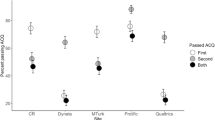Abstract
From the first presentation of extreme programming on, pair programming has attracted a wide range of programmers to work together in front of one display. The proposed advantages of pair programming are a faster development cycle and code with higher quality. However, the nearly doubled personnel cost when compared to single developers seems to outweigh these advantages. Instead of showing the superiority of pair programming, we seek an alternative. Can a single developer be assisted by an already known technique with which he produces the quality of pairs with only a fraction of the cost? The answer with some restrictions is: yes, he can. Reviews are a reasonable candidate with respect to code quality and cost.
Similar content being viewed by others
References
Cockburn, A., and Williams, L. 2000. The costs and benefits of pair programming. In eXtreme Programming and Flexible Processes in Software Engineering (XP2000). Cagliari, Italy, June.
Cohen, J. 1977. Statistical Power Analysis for the Behavioral Sciences. Academic Press.
Gilb, T., and Graham, D. 1993. Software Inspection. Addison-Wesley.
Humphrey, W. 1995. A Discipline for Software Engineering. Addison-Wesley.
McDowell, C., Werner, L., Bullock, H., and Fernald, J. 2002. The effects of pair-programming on performance in an introductory programming course. In SIGCSE Technical Symposium on Computer Science Education. Cincinnati, Kentucky, USA, pp. 38–42.
Müller, M., and Padberg, F. 2002. Extreme programming from an engineering economics point of view. In International Workshop on Economics-Driven Software Engineering Research (EDSER). Orlando, Florida, USA, May.
Nawrocki, J., and Wojciechowski, A. 2001. Experimental evaluation of pair programming. In European Software Control and Metrics (Escom). London, UK.
Nosek, J. 1998. The case for collaborative programming. Communications of the ACM 41(3): 105–108, March.
PSP resources page. http://www.ipd.uka.de/PSP/.
Thaka, R., and Gentleman, R. 1996. A language for data analysis and graphics. Journal of Computational and Graphical Statistics 5(3): 299–314.
Williams, L., and Kessler, R. 2000. The effects of pair-pressure and pair-learning on software engineering education. In Conference on Software Engineering Education and Training. Austin, Texas, USA, pp. 59–65, March.
Williams, L., Kessler, R., Cunningham, W., and Jeffries, R. 2000. Strengthening the case for pairprogramming. IEEE Software, 19–25, July/August.
Rights and permissions
About this article
Cite this article
Müller, M.M. Are Reviews an Alternative to Pair Programming?. Empirical Software Engineering 9, 335–351 (2004). https://doi.org/10.1023/B:EMSE.0000039883.47173.39
Issue Date:
DOI: https://doi.org/10.1023/B:EMSE.0000039883.47173.39




